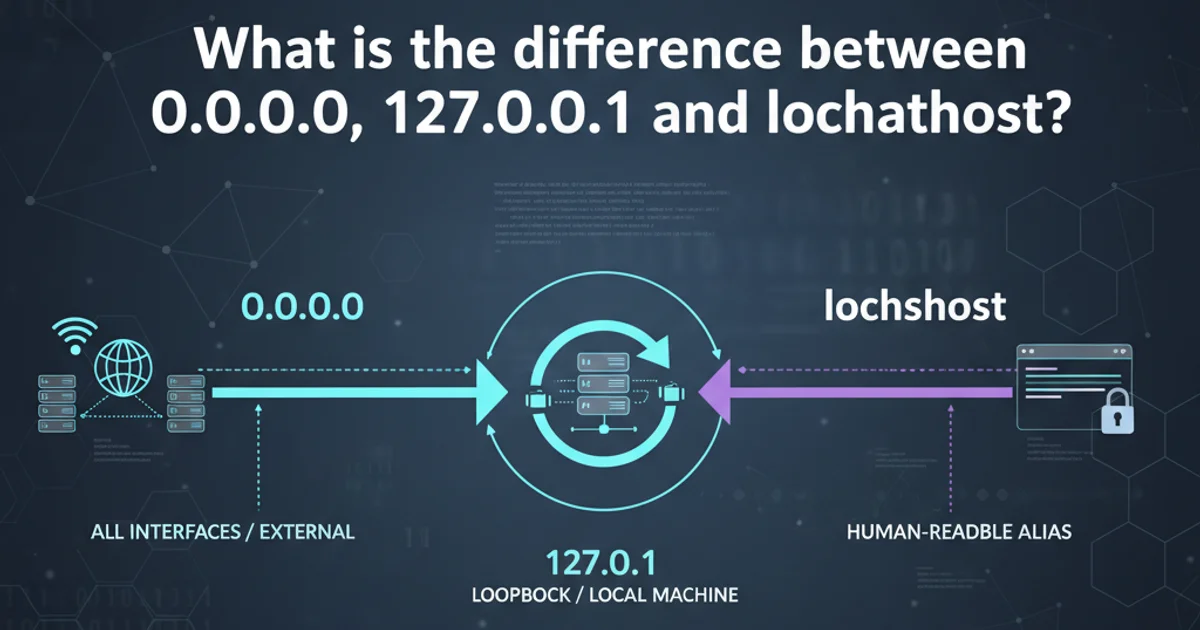What is the difference between 0.0.0.0, 127.0.0.1 and localhost?
Categories:
Understanding 0.0.0.0, 127.0.0.1, and localhost: A Guide to Network Addresses

Demystify the common network addresses 0.0.0.0, 127.0.0.1, and localhost. Learn their distinct meanings, uses, and how they impact network communication and application binding.
In the world of networking and application development, you frequently encounter specific IP addresses and hostnames that, while seemingly similar, serve fundamentally different purposes. Understanding the distinctions between 0.0.0.0, 127.0.0.1, and localhost is crucial for configuring network services, troubleshooting connectivity issues, and ensuring your applications behave as expected. This article will break down each of these identifiers, explaining their roles and practical implications.
What is 127.0.0.1 and localhost?
127.0.0.1 is a special-purpose IPv4 address reserved for loopback communication. It's often referred to as the 'loopback address'. When a program sends data to 127.0.0.1, the data is immediately routed back to the same machine, bypassing any physical network interface. This means the traffic never leaves your computer.
localhost is the standard hostname that resolves to the loopback IP address, 127.0.0.1 (and ::1 for IPv6). It's a human-readable alias for the loopback interface. Both 127.0.0.1 and localhost are used for testing applications locally without involving external network connections. For example, a web server running on your machine can be accessed by your web browser using http://localhost or http://127.0.0.1.
ping 127.0.0.1
ping localhost
Pinging the loopback address and hostname to demonstrate local connectivity.
localhost typically resolves to 127.0.0.1, it's technically possible to modify your system's hosts file to point localhost to a different IP address. However, this is highly discouraged as it can break expected system behavior.What is 0.0.0.0?
0.0.0.0 is a non-routable meta-address used to designate an invalid, unknown, or non-applicable target. When used as a source address, it means 'this host on any network'. More commonly, when an application or service binds to 0.0.0.0, it means it will listen for incoming connections on all available network interfaces (e.g., Ethernet, Wi-Fi, loopback). This makes the service accessible from both the local machine and other machines on the network, provided firewall rules allow it.
For example, if a web server binds to 0.0.0.0:80, it will accept connections on port 80 from 127.0.0.1 (localhost), your local network IP (e.g., 192.168.1.100), and any other IP addresses assigned to your machine.
flowchart TD
A["Application (e.g., Web Server)"]
subgraph Binding to 127.0.0.1
B["Listens on 127.0.0.1:Port"]
end
subgraph Binding to 0.0.0.0
C["Listens on 0.0.0.0:Port"]
end
A --> B
A --> C
UserLocal["Local User (Browser)"]
UserRemote["Remote User (Another PC)"]
UserLocal -- "Connects to 127.0.0.1" --> B
UserLocal -- "Connects to 127.0.0.1 or Local IP" --> C
UserRemote -- "Connects to Local IP" --> C
UserRemote -.-> B["Cannot connect to 127.0.0.1"]
style B fill:#f9f,stroke:#333,stroke-width:2px
style C fill:#bbf,stroke:#333,stroke-width:2pxComparison of application binding to 127.0.0.1 vs. 0.0.0.0
Key Differences and Use Cases
The primary distinction lies in scope: 127.0.0.1 (and localhost) is strictly for internal communication within the same machine, while 0.0.0.0 is for listening on all available network interfaces, making a service accessible externally.
127.0.0.1/localhost: Ideal for development and testing. If you want your application to only be accessible from the machine it's running on, bind it to127.0.0.1. This is a security best practice for services not intended for public access.0.0.0.0: Used when you want your application to be accessible from other devices on the network or the internet. This is common for production web servers, APIs, or any service that needs to be reached by clients beyond the local machine. When binding to0.0.0.0, the service will listen on all IP addresses configured on the host, including127.0.0.1and any external IPs.
0.0.0.0 makes your service potentially accessible to the entire network. Always ensure proper firewall rules and authentication are in place if you expose services this way, especially in production environments.Practical Examples in Jekyll
When developing with Jekyll, you often use the jekyll serve command. Let's look at how these addresses apply:
By default, jekyll serve binds to 127.0.0.1 (or localhost). This means your Jekyll site is only accessible from the browser on the same machine where you're running the command, typically at http://localhost:4000.
If you want to preview your Jekyll site on other devices on your local network (e.g., a mobile phone, another computer), you need to tell Jekyll to bind to all available interfaces. You can do this using the --host option:
jekyll serve --host 0.0.0.0
After running this command, your Jekyll site will be accessible from other devices on your network using your machine's local IP address (e.g., http://192.168.1.100:4000).
# Default Jekyll serve (binds to 127.0.0.1)
jekyll serve
# Jekyll serve accessible from local network (binds to 0.0.0.0)
jekyll serve --host 0.0.0.0
Jekyll serve commands demonstrating binding to different addresses.